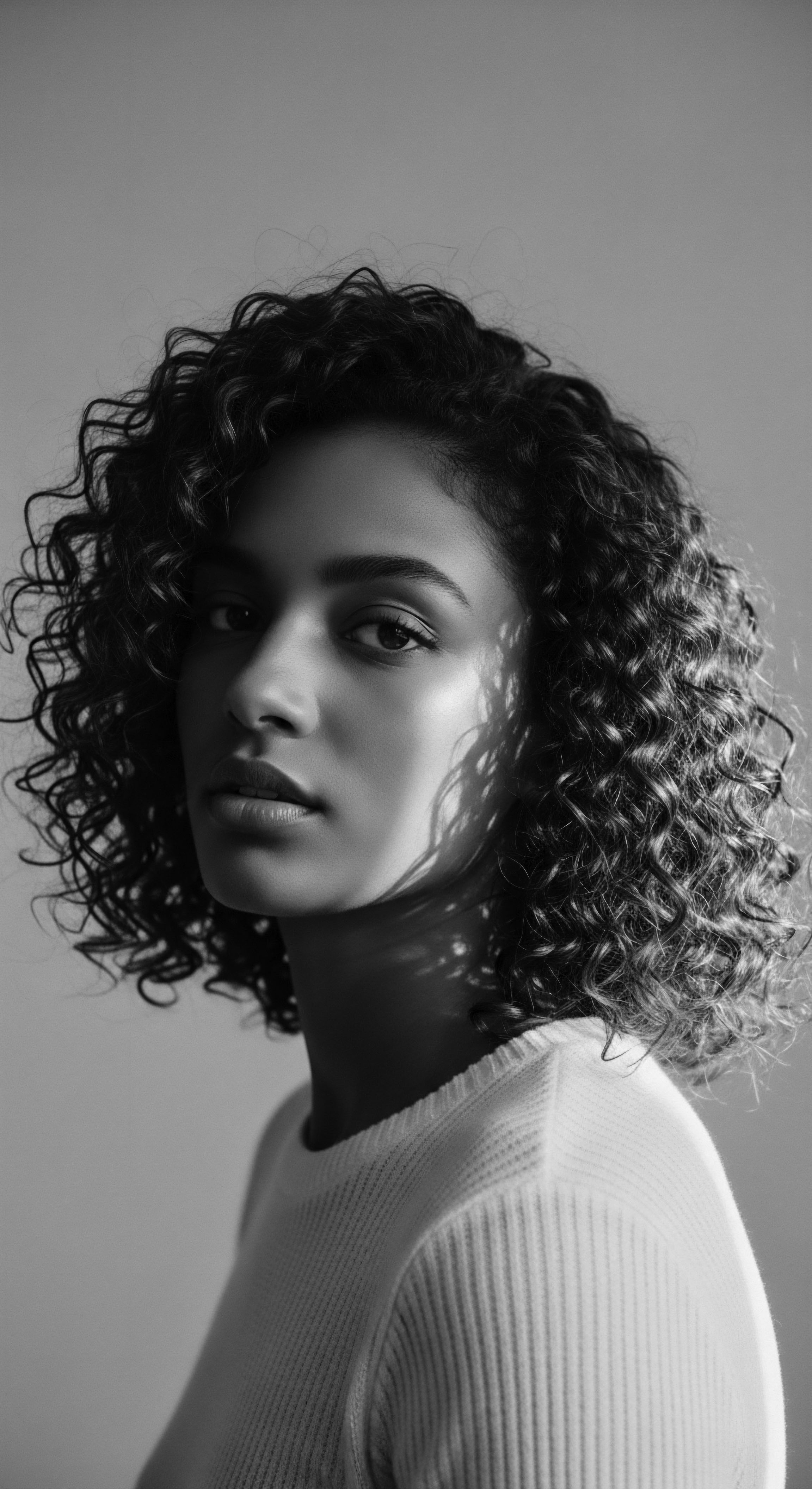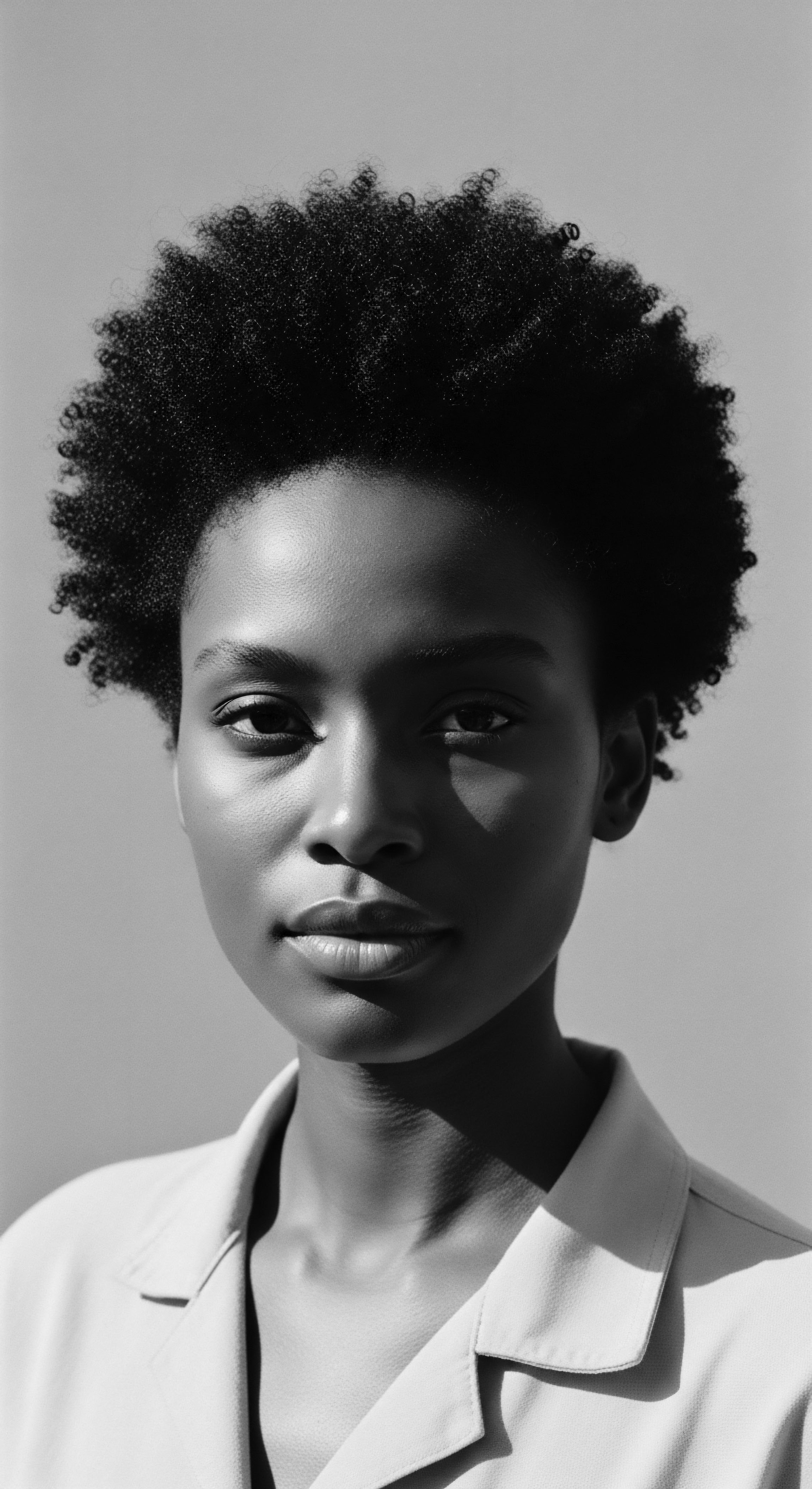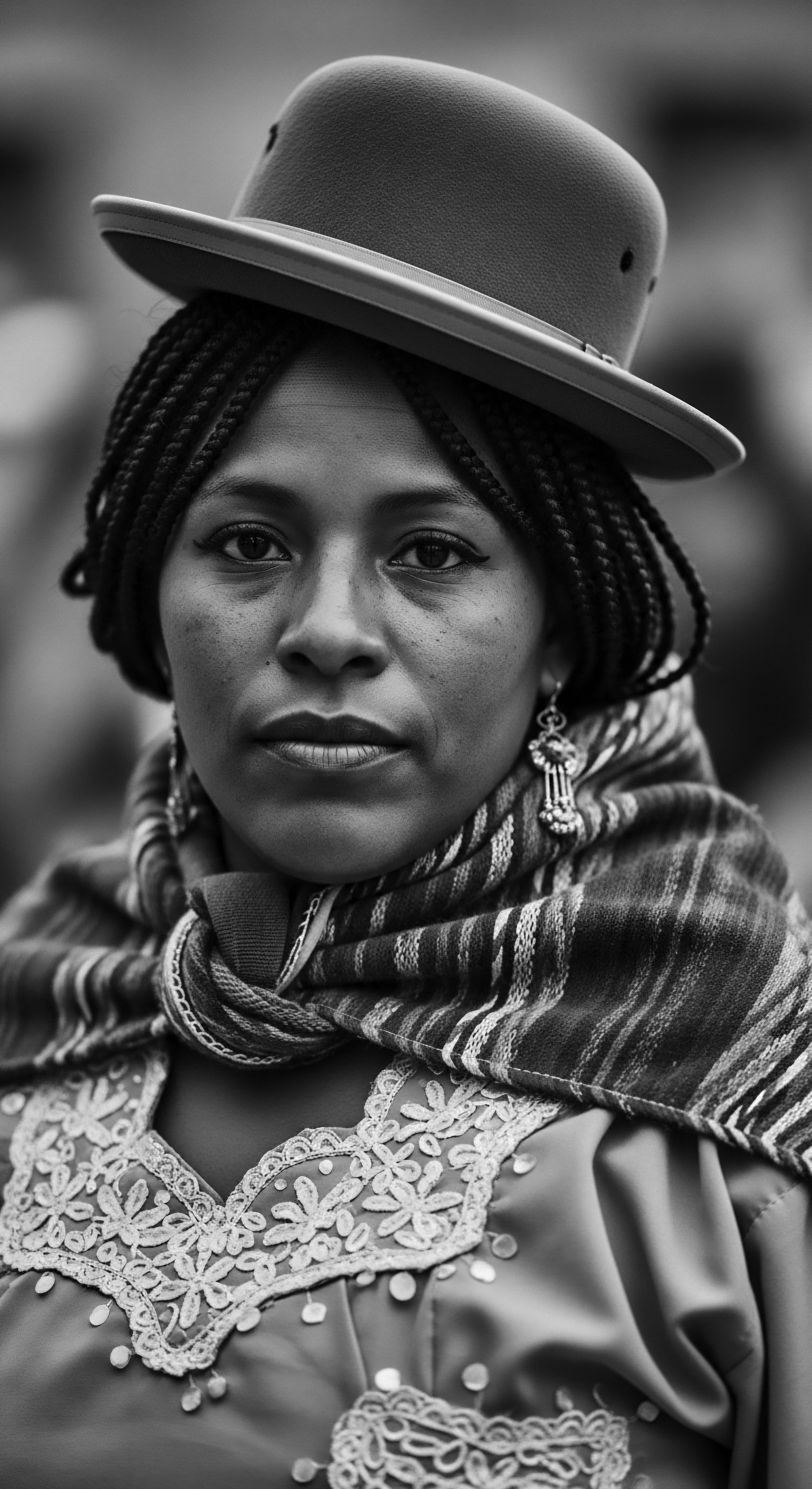
Roots
The very curls that crown a textured head hold within them an ancient wisdom, a silent song passed through generations. We speak of hair not as mere biological filament, but as a living scroll, inscribed with the experiences of those who came before us. To understand why ancestral customs maintain their hold on textured hair care, one must first listen to the echoes from the source, tracing the lineage of each strand back to its earliest beginnings on the continent of Africa. Our hair, in its intricate coiled patterns and abundant volume, carries the memory of landscapes and civilizations where its care was a sacred art.
Consider the elemental biology of textured hair, its unique helical structure, and how early peoples came to understand its needs. The distinct coil, ranging from gentle waves to tightly wound spirals, presents particular characteristics ❉ a heightened propensity for dryness due to the open cuticle at each curve and a tendency toward breakage if not handled with profound care. For our forebears, this understanding arrived not through microscopes, but through generations of careful observation and an intuitive connection with nature’s rhythms. They learned the language of their hair, discerning its thirst, its strength, its vulnerabilities.

Unraveling Hair’s Earliest Code
Long before modern science rendered illustrations of hair follicles and protein structures, ancestral communities possessed a sophisticated, experiential grasp of hair’s fundamental nature. They recognized that the varied shapes of our hair were not random; they were part of a grand design, requiring methods of tending that honored their particular formation. The practice of oiling, for instance, a cornerstone of traditional African hair care, was a direct response to hair’s need for moisture retention, coating the strand to guard against desiccation under the sun.
From the earliest known archaeological records, tools crafted for hair maintenance appear, signifying the care given to crowns. These were not simply functional implements; they were often adorned, themselves works of art. Such artifacts speak to an era when hair care was not a hurried chore but a deliberate, almost meditative act. This continuity of intention, stretching back millennia, offers a glimpse into the foundational wisdom that informs even today’s most effective regimens.
The intrinsic helical form of textured hair guided ancestral care practices, shaping a heritage of protective methods.

What Are the Ancestral Foundations of Hair Nomenclature?
The language we use to describe textured hair today, while sometimes technical, draws an unseen lineage from ancient descriptors. In many African societies, words for hair types and styles carried deep sociological and spiritual weight. Hair was categorized not just by appearance but by its connection to identity, status, and community.
For example, specific braiding patterns in certain West African cultures held names that recounted lineages or marked rites of passage, serving as a complex non-verbal communication system (Sieber & Herreman, 2000). This was a nomenclature rooted in lived experience and shared cultural understanding, far removed from arbitrary numerical systems.
This historical perspective invites us to re-examine modern classification systems, considering whether they adequately capture the diversity and cultural significance present in the spectrum of textured hair. The traditional terms were often infused with respect and acknowledgement of the hair’s role in one’s place in the world, differing markedly from systems that might, at times, inadvertently categorize and thereby diminish.
Here is a contrast of historical and modern ways of seeing hair characteristics:
| Ancestral Observation Hair thirsts for oils and plant butters |
| Contemporary Scientific Correlate Hair's helical shape impedes natural oil flow, requiring external emollients. |
| Ancestral Observation Hair holds spiritual power and ancestral ties |
| Contemporary Scientific Correlate Hair serves as a social and cultural marker of identity and belonging. |
| Ancestral Observation Hair communicates social rank and life events |
| Contemporary Scientific Correlate Hair styling visually signifies personal identity and cultural affiliation. |
| Ancestral Observation The enduring wisdom of ancestral observations often mirrors modern scientific understanding, viewed through a lens of shared heritage. |
The inherent properties of textured hair dictated much of its traditional care. The scalp, often more exposed by certain styles, would have been tended with plant-based unguents to protect it from the sun and promote a healthy environment for growth. The practices of coiling, twisting, and braiding, common across African communities for millennia, offered both protection and artistic expression.
These methods kept the fragile ends guarded, reducing tangling and breakage, a practical response to the hair’s very structure. This deep, almost intuitive knowledge of hair’s needs formed the initial layer of care, shaping daily rituals and collective understanding.

Ritual
From the foundational insights into hair’s natural inclinations, care practices blossomed into elaborate rituals, deeply interwoven with daily existence and communal bonds. These practices, far from being simply about cleanliness or appearance, became central to the expression of identity, status, and spiritual connection within various African societies. The hands that tended hair were not just stylists; they were keepers of ancestral wisdom, transmitting both skill and story with each movement. This passing down of knowledge, often from elder to younger, formed an unbroken chain of heritage, ensuring that the customs endured through time and across vast distances.
The act of grooming, whether a mother braiding her child’s hair or women gathering in a communal space, frequently transcended the practical. It became a social event, a moment for storytelling, for sharing wisdom, for strengthening familial and community ties. These shared experiences imprinted the significance of hair care upon the collective memory, making it an act of cultural continuity. The rhythm of the comb, the gentle tension of the braid, the scent of shea butter warming in the hands—these sensory details became markers of belonging, solidifying the importance of hair traditions.

The Art of Protective Styling Through the Ages
Protective styling, a practice widely celebrated today for its role in preserving hair length and reducing manipulation, holds an ancient lineage. Across Africa, styles such as braids, twists, and locs served multiple purposes ❉ protection from harsh environments, clear indicators of social standing, and expressions of profound artistic skill. These styles were not merely aesthetic choices; they were living archives, carrying messages about a person’s marital status, age, tribal affiliation, wealth, and spiritual beliefs. For instance, in many West African cultures, intricate braiding patterns could signal readiness for marriage or a journey taken.
Consider the meticulous care required to craft these enduring styles. The patience, the precision, the hours spent in communal settings—all speak to a deep reverence for hair and its role in cultural expression. The very durability of these styles meant less daily manipulation, a natural protective measure against breakage, especially for textured hair which thrives on reduced interference.
Traditional styling practices wove practical hair protection with profound cultural meaning and community connection.
The tools used were often simple yet highly effective, crafted from natural materials. Combs with wide teeth, carved from wood or bone, were designed to gently detangle coiled strands. Oils and butters extracted from local plants provided lubrication and nourishment. These tools, alongside the skilled hands that wielded them, formed the complete toolkit of ancestral hair care.
Traditional techniques and their purpose echo through time:
- Braiding ❉ A foundational practice, found in ancient Egyptian depictions dating back to 3500 BCE, served to signify tribal identity, wealth, marital status, and religion in numerous African groups.
- Twisting ❉ Often used to denote tribal affiliation and social status, offering a simpler yet equally protective alternative to braiding.
- Locing ❉ In some African nations, such as among the Akan people of Ghana, locks symbolized higher power and were reserved for priests or warriors, representing strength.
- Bantu Knots ❉ Thought to have originated with the Zulu Kingdom in Southern Africa, these styles represented strength and community, with the elevated knots holding spiritual significance.

Ingredients from the Ancestral Gardens
The understanding of beneficial ingredients for hair care was gleaned directly from the earth. Local flora provided the rich emollients, cleansers, and conditioners that kept textured hair healthy and strong. Shea butter, sourced from the karite tree, for example, has been used for centuries across West Africa for its moisturizing and protective properties.
Its ability to seal in moisture and provide a barrier against environmental aggressors aligns perfectly with the needs of coiled strands prone to dryness. Similarly, natural clays, plant extracts, and indigenous oils formed the foundation of effective, holistic hair care regimens.
This traditional knowledge of ingredients extended beyond mere application; it included an understanding of their harvest, preparation, and spiritual properties. The gathering of these materials was often part of a ritual itself, a connection to the land that provided sustenance and healing. This deep integration of care practices with the natural environment speaks to a reverence for resources and a mindful approach to wellbeing.
| Traditional Ingredient Shea Butter |
| Historical Application in Hair Care Moisturizing and protecting against sun. |
| Modern Scientific Recognition of Benefit Rich in fatty acids and vitamins for deep conditioning and barrier function. |
| Traditional Ingredient Aloe Vera |
| Historical Application in Hair Care Soothing scalp irritations, promoting growth. |
| Modern Scientific Recognition of Benefit Contains enzymes that promote healthy cell growth and anti-inflammatory properties. |
| Traditional Ingredient Fenugreek |
| Historical Application in Hair Care Strengthening strands, reducing shedding. |
| Modern Scientific Recognition of Benefit Contains proteins and nicotinic acid beneficial for hair strengthening. |
| Traditional Ingredient The efficacy of ancestral botanical remedies continues to be affirmed by contemporary understanding, preserving a legacy of natural care. |
These traditional practices, honed over centuries, represent a living testament to ancestral ingenuity. They offer not only methods for physical care but also a profound connection to cultural heritage and community identity. The echoes of these rituals resonate today, guiding many in their approach to textured hair care.

Relay
The resilience of textured hair traditions, born from ancient wisdom and carried through periods of profound disruption, stands as a powerful testament to the human spirit. The transatlantic slave trade, a period of unparalleled cruelty, sought to systematically strip enslaved Africans of their identity, with hair often being among the first targets. Upon arrival, forced head shaves were common, a deliberate act to sever connections to culture, community, and self (Johnson & Bankhead, 2014, p.
91). Despite such brutal attempts at erasure, hair practices survived, transformed, and became secret codes of communication, symbols of resistance, and enduring markers of heritage.
This ability to maintain and adapt traditions, even under duress, speaks volumes about the deep importance of hair care for people of African descent. It became a whispered language, a visual story told on the head when spoken words were forbidden. The ingenuity of those who maintained their customs, utilizing whatever materials were available—even sheep grooming tools or grease for lubrication—highlights an unyielding commitment to cultural memory. These acts, seemingly small, held immense weight, preserving a sense of self and collective identity against overwhelming odds.

Hair as an Ancestral Map and Resistance
Beyond aesthetic appeal, hair historically served as a map, literally and figuratively. During periods of enslavement, intricate braiding patterns were reportedly used to convey escape routes and hide seeds for future sustenance, transforming hair into a canvas of survival and coded communication. This silent language, passed hand-to-hand and mind-to-mind, allowed for a continuity of cultural practice under the cloak of invisibility, a quiet defiance of oppression. These stories of resistance, woven into the very strands, elevate textured hair care beyond mere hygiene or beauty to a profound act of self-preservation and ancestral honoring.
The deliberate choice to wear specific styles, even when facing societal pressure or legal restrictions, became a potent expression of identity. From the Tignon Laws in 18th-century Louisiana, which mandated head coverings for Black and multiracial women to denote their supposedly inferior status, to the modern-day CROWN Act, hair has remained a battleground for dignity and self-determination. The ongoing struggle to protect the right to wear natural, traditional styles shows that the fight for hair freedom is deeply rooted in this long history of resistance.
The persistence of traditional hair practices showcases an enduring resilience against historical attempts at cultural erasure.

Echoes of Identity in Each Coil
The connection between textured hair care and identity is undeniable. For many, the choice to embrace natural hair textures and traditional styles is a reclamation of heritage, a conscious return to practices that acknowledge their ancestral roots. This choice stands as a celebration of beauty standards that were once denigrated, but which always held profound meaning within diasporic communities. The textures, once deemed “unprofessional” or “unruly” by external forces, are now recognized as inherent expressions of Black and mixed-race beauty.
The revitalization of styles such as cornrows, Bantu knots, and various braided forms in contemporary society points to a deliberate desire to reconnect with lineage. This resurgence reflects a collective memory, a seeking out of practices that affirm belonging and pride. The act of learning these styles, perhaps from an elder or through shared community knowledge, becomes a personal journey into one’s own cultural past, deepening a sense of self.

Shaping Tomorrow’s Crowns
As contemporary textured hair care evolves, it carries forward the torch of tradition, integrating modern understanding with ancient wisdom. Scientific insights into hair’s structure and needs inform product development, yet the guiding principles often align with long-held ancestral practices ❉ moisture retention, gentle handling, and protective styling. The global reach of Black hair traditions today, influencing fashion and beauty worldwide, highlights their lasting impact and cultural significance.
The dialogue between ancient practice and modern science enriches both. Understanding the molecular basis of the curl pattern, for example, can lead to products that enhance the efficacy of traditional oiling. Similarly, modern research can validate the anecdotal benefits of plant-based ingredients used for centuries, providing a scientific explanation for ancestral remedies. This dynamic interplay ensures that traditions remain living, adaptable, and relevant for future generations.
The legacy of textured hair care, then, is a continuous relay, a passing of the baton from one generation to the next. It carries the weight of history, the spirit of resilience, and the creative expression of a people who never stopped finding beauty and meaning in their coils and crowns. This enduring connection ensures that traditions matter not only for preserving the past but for shaping a vibrant, self-affirming future for textured hair.

Reflection
To consider why traditions hold significance for textured hair care is to listen to the whisper of countless generations. Each coil and curl holds a story, a memory etched into its very being from the hands that first tended it, the rituals that defined its care, and the meaning it held within communities. Our textured hair, truly, is a living library, its strands the delicate pages of a collective memoir. This is the ‘Soul of a Strand’ ethos made tangible ❉ an acknowledgment that our hair carries not only genetic codes but also cultural narratives, ancestral echoes, and the enduring spirit of resilience.
The customs passed down through time, whether a particular method of braiding or the knowledge of a specific plant’s properties, are more than mere techniques. They are conduits to a deeper self, pathways to understanding our place in a heritage of strength and beauty. They remind us that the act of caring for textured hair reaches beyond the superficial; it is an act of honoring lineage, a silent conversation with those who navigated their own hair journeys through joy, struggle, and eventual triumph. In preserving these traditions, we do not simply maintain a style or a regimen; we uphold a legacy, ensuring the vibrant, intricate stories of our hair continue to be written for all time.

References
- Byrd, A. and Tharps, L. (2001). Hair Story ❉ Untangling the Roots of Black Hair in America. St. Martin’s Griffin.
- Johnson, T. and Bankhead, T. (2014). Hair It Is ❉ Examining the Experiences of Black Women with Natural Hair. Open Journal of Social Sciences, 2, 86-100.
- Sieber, R. and Herreman, F. (2000). Hair in African Art and Culture. Museum for African Art.
- Sweet, L. (2019). The Natural Hair Handbook ❉ A Guide for Textured Hair Care. New Earth Press.
- Walker, A. (1997). Andre Talks Hair! Simon & Schuster.
- Mercer, K. (1994). Welcome to the Jungle ❉ New Positions in Black Cultural Studies. Routledge.
- Rooks, N.M. (1996). Hair Raising ❉ Beauty, Culture, and African American Women. Rutgers University Press.
